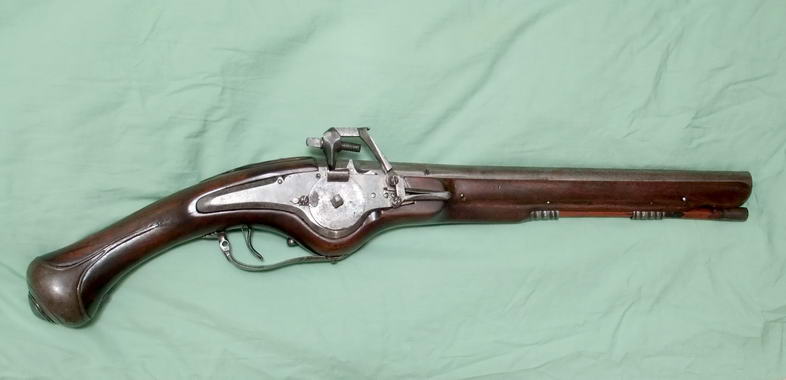Animated Wheellock Mechanism
17th Century wheellock
This page shows a schematic drawing of a wheellock mechanism dating from the early 1600s. The various moving components have been animated to demonstrate how the wheellock mechanism works.

The photo on the right shoes the pistol to which the lock is fitted. The gun was manufactured in Suhl Germany in the early 17th century. It has a 14" barrel and the pistol is 22½" overall. It is a good example of a German military wheellock pistol of that period.
Animated wheellock mechanism
The schematic drawing below shows the outside view of the wheellock mechanism in the lower section, the inside view in the upper section, The insert at the top shows an animated cross-section of the trigger mechanism whose action is in the plane perpendicular to the lock plate.
The outside view of the lock shows the bracket fixing the cock and cock spring drawn semi-transparent so that the operation of the spring loaded cam at the base of the cock arm is clear. In the inside view the bridle supporting the wheel axle is also shown semi-transparent to expose the chain and cam operation.
Wheellock firing sequence
The sequence of events to load and fire a wheellock gun is as follows:
Load (not shown)
The power charge is poured into the barrel, followed by the ball and finally the wadding. These are tamped with the ramrod.
Span
The cock (referred to as the 'dog' in earlier times) is rotated away from the wheel and is held in place by the cock spring pressing on its cam shaped heel. The pan cover is then slid back to expose the pan which has the sector of the wheel cutting through its base ready for spanning and priming. The operator then engages his spanner onto the square section of the wheel axle, and 'spans' or rotates the wheel, winding up the chain which in turn tensions the mainspring. After winding about three quarters of a turn the blind hole in the wheel lines up with the nose of the sear which has been pressing against the wheel by force of one leaf of the sear spring. The sear pivots into this indentation locking the wheel. As it pivots the sear latch is pushed under the sear arm by the other leaf of the sear spring locking the sear in place which thus locks the wheel. The operator then removes the spanner from the wheel axle, the main spring is now to applying considerable torque on the wheel.
Prime
The pan is then primed with powder, and the pan cover slid shut. The cock is rotated back over the pan cover so that the iron pyrites in its jaws rests on the pan cover, again under pressure from the cock spring on the outside of the plate.
Fire
The pistol trigger is a spring loaded arm lying in front of the sear latch. On pulling the trigger, the sear latch is pushed away from the sear arm so it no longer holding it in the indentation in the wheel. The pressure of the sloping sides of the indentation against on the rounded nose of the sear arm pushes the sear nose back, leaving the wheel free to rapidly turn under the tension of the mainspring.
As soon as the wheel is released by the sear, the mainspring pulling on the chain wrapped around the cam on its axle rapidly rotates the cam and wheel. As the cam rotates its long lobe pushes against the pan cover arm. The movement of the pan cover arm pushes the pan cover back away from the pan. As the pan cover slides away the pyrites pressing down on it now falls onto the now rotating wheel, producing sparks. Since the section of the wheel where then pyrites touches is surrounded by the pan full of gunpowder, the powder ignites and the hot gas and radiant heat is transferred to the main charge in the breech of the barrel via the vent hole in the side of the pan. The main charge ignites and the gun discharges.